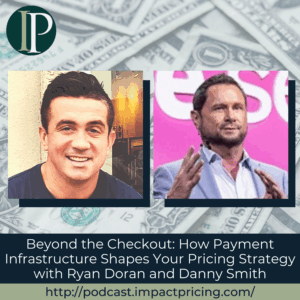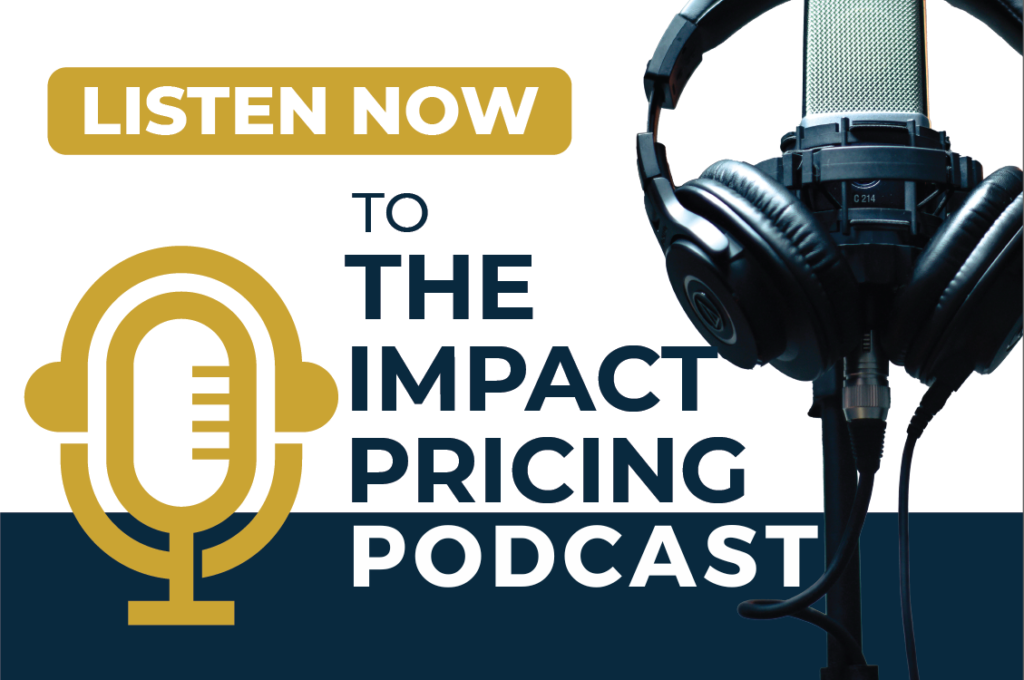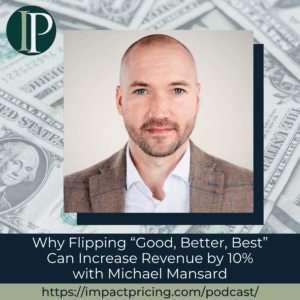
Danny Smith is a Solution Architect at Stripe, working on AI-driven commerce innovations and partnering with AWS.
In this episode, Ryan and Danny explore the critical intersection of pricing strategy and payment infrastructure, discussing how AI is transforming both the mechanics of pricing implementation and the challenge of pricing AI products themselves.
Podcast: Play in new window | Download
Why you have to check out today’s podcast:
- Understand the difference between billing systems and payment systems and how they work together.
- Learn why flexible technical infrastructure is essential for modern pricing strategies.
- Discover how AI is enabling hyper-personalized shopping experiences with built-in guardrails.
“Your pricing strategy is only as good as the background tech that you have to operationalize it. If you have a legacy monolithic stack and you can come up with these great strategies, but it takes you six months to implement that strategy, then you’ve probably been left behind already.”
– Danny Smith
Topics Covered:
02:15 – How Ryan got into pricing through product development and payment flows.
04:30 – Danny’s journey from cloud architecture to payments infrastructure.
06:45 – The difference between billing systems and payment systems.
10:20 – Why new billing companies continue to emerge despite established players.
14:15 – How AI is accelerating data utilization in pricing decisions.
17:30 – The dual challenge: using AI for pricing vs. pricing AI products.
19:45 – Hyper-personalized shopping with AI agents and built-in guardrails.
23:10 – The ethical concerns of “sleazy price segmentation” and AI pricing.
28:40 – Agent-to-agent negotiations and policy engines.
31:20 – How AI products are changing pricing models: tokens, credits, and hybrid approaches.
35:15 – Creating “action units” to translate technical complexity into business value.
Key Takeaways:
“Data is basically the new margin. What you can do with it is only gaining in value.” – Ryan Doran
“We’ve implemented API level technology that will create a budget… and it will create a virtual debit card on the backend for that exact amount, tied to today as an expiration date, tied to that particular transaction.” – Danny Smith
Resources and People Mentioned:
- Turkois: https://turkois.io/
- Vanilla POS: https://vanillapos.io/
- Stripe: https://stripe.com
- Perplexity: https://www.perplexity.ai/
- OpenAI: https://openai.com/
- Chargebee, Chargeify, Zora: Alternative billing platforms
- MCP Server: Technology enabling AI agents to interact with Stripe for dynamic pricing
Connect with Ryan Doran:
- Website: https://turkois.io/
- Email: [email protected]
Connect with Danny Smith:
- Contact through Ryan Doran
Connect with Mark Stiving:
- LinkedIn: https://www.linkedin.com/in/stiving/
- Email: [email protected]
Full Interview Transcript
(Note: This transcript was created with an AI transcription service. Please forgive any transcription or grammatical errors. We probably sounded better in real life.)
Danny Smith
Your pricing strategy is only as good as the background tech that you have to operationalize it. So if you have a legacy like monolithic stack and you can come up with these great strategies, but it takes you six months to go implement that strategy, then you’ve probably been left behind already.
[Intro / Ad]
Mark Stiving
Welcome to Impact Pricing, the podcast where we discuss pricing, value, and the dynamic relationship between them. I’m Mark Stiving, and I run bootcamps to help companies get paid more. We have two guests today.
Our first guest is Ryan Doran. Here are three things you wanna know about Ryan before we start. He is partner in Lead Creative and head of UI UX for Turkois. I hope that’s how you say it. And he’s been doing this for over 17 years, wow. He has a deep expertise in monetization strategy, payments, scaling technology businesses, and he’s passionate about solving the tough problems at the intersection of growth, pricing, and payment infrastructure.
Our second guest is Danny Smith. Here are three things you want to know about Danny. First, he’s a solution architect at a company you’ve probably heard of before. It’s called Stripe. And he works on partnering with AWS on AI-driven commerce innovations. He was a senior solutions architect at ServiceNow, director of cloud solutions at TechData.
Welcome, Danny. I just have to tell you, I am nervous because I’m talking to two technical people and I have not played in tech space for, oh, forever. So please be gentle on me. Absolutely. We’ll try to dumb it down for me to understand anything we talk about today. So Ryan, how did you get into pricing or do you think of yourself as being in pricing?
Ryan Doran
Sure. Yeah. I actually think of myself as being in product. So I’m a designer by trade and happen to be one of the owners of our company. And when you’re building products that have payment backbones enabled through them, you have to start thinking about tools that enable your customers to build pricing models, right? So if you’re building a point of sale, which we do have, you have to be able to say, what are the guardrails of the product that’s being priced?
Or if you’re building a product that can have variable-based pricing, which we do allow in our platform, Are you saying that it can be any number up on checkout? Are you saying that there are guardrails attached to that number that can only be as low as can only be as high as can it be combined with other products, things like that. And then through Stripe, we’re able to also do things for in-person payments, like kick off a subscription, right?
Enable subscriptions from an onsite payment, capture a method of payment, apply that to a customer record and build a customer portal. from that record that they can access and manage their invoices from. So all that attaches to a product we might build, but you have to put yourself into the place of our customer, the business, and say what pricing mechanisms do they need to enable these kinds of products being purchased.
Mark Stiving
Okay, I wanna make sure I understand this right. Let’s assume I wanna go build a new SaaS platform of some sort. And I actually don’t have the engineers, I don’t wanna build it. I hire you and your company, you guys build it for me.
And in the end, I need to get someone to pay me for it. And so you’re gonna build in the payment structure, the payments infrastructure, and you’re gonna help me through how we’re gonna price it and not necessarily set the price levels, but at least the pricing structures.
Ryan Doran
Sure, exactly. We would call that payment flows, right? How is the payment going to flow through the platform? Who’s going to be the merchant of record in that platform that you’re building? Are there any service fees applied, right? Danny can talk a little bit more about how Stripe sees that kind of relationship.
Mark Stiving
Awesome. Danny, how did you get into pricing or are you in pricing?
Danny Smith
Yeah, no, great question. So I’m an architect by trade. My previous background, I was in cloud architecture and building cloud solutions and workflow automations at companies like service now and one of the things that i really started thinking about is. You know you can build a workflow, you can build an awesome cloud-based solutions platform, as you were mentioning Mark. But how do you monetize that right so companies like OpenAI.
For while there everybody was using the free version of chat but if you want to upgrade you want to upsell opportunities to get access to the more advanced models the beta features things like that. How do i monetize that strategy so companies like OpenAI, Perplexity. We have three hundred thousand billing customers so I can rattle off a ton of big name series xm.
They come to us with basically their pricing strategy needs and what we provide them is payments infrastructure. We basically obfuscate all the complexity of implementing that at a global scale. Cause at the end of the day, pricing, it’s not just about strategy, but it’s also about architecture. It’s like, if you don’t have a flexible platform.
You’re leaking money basically with every transaction if you want to implement things like a hybrid pricing model as you see with some of these companies it’s definitely seat based plus usage based. The more that the market pushes for more complex pricing strategies we have to build that underlying architecture and infrastructure that helps the technology meet the business need.
So we don’t really sell a product per se, we sell an infrastructure that allows you to execute on a million different pricing strategies. So I got dragged into pricing by working for a company that helps to implement global pricing use cases across every vertical you can think of.
Mark Stiving
Yeah. Makes sense. By the way, next time you’re listing major companies you work with, mention Impact Pricing, okay? Impact Pricing. Yeah.
Danny Smith
That should be the first one, I think, right?
Ryan Doran
Is that right?
Danny Smith
Yeah. It should be. Absolutely. I know the texture. Maybe tell us about how that experience has been on screen, but I’ll save that for your own edification.
Mark Stiving
Yeah, I was gonna say, you don’t wanna know. I’m not the guy that does these things. So, all right, great concept so far. And so, I talk to people who focus on, how do we do pricing? How do we think about the value to our customers? And this whole concept of AI is throwing a whole bunch of monkey wrenches in the middle of all of this pricing.
Things are changing pretty dramatically. And so when we start thinking about pricing, let me start with this. What’s the difference between a billing system and a payment system? As in, could I use Chargebee or Chargeify or Zora and then still use Stripe as my payments? Is that how that works? Or is Stripe actually doing the billing nowadays?
Danny Smith
We do both. So I love the question, right? Because we’re actually rated in the Gartner magic upper right quadrant and also Forrester as the number one company in the world that integrates payments and billing. But you can also use this independently. So we have many, many customers, for example, that use Zora for billing. So think of it like the subscription engine, but you have to send an invoice to collect payment.
So you can interact directly with Stripes APIs to generate that invoice and collect payment. Or if you want to use a combined platform approach, you can use Stripe as your subscription engine. These are the OpenAIs of the world, for example, that use both our subscription engine and our invoicing engine.
Because at the end of the day, that’s what a billing platform basically is, is, you know, managing the churn of recurring payments, implementing that logic from a subscription standpoint, and then managing the actual collection of payments. So we do both, but we also support what we call multi-processor. So you can use Stripe billing and use even one of our competitors for payments. So Stripe billing is a standalone product.
So you could use Stripe billing and use add in or PayPal on the backend, WorldPay, whoever. Because we’re definitely moving towards what we call a composable architecture we understand that. Enterprise companies for example are not typically gonna go all in with one.
Payments provider they’re gonna have backups. A perfect example is like Uber Eats. There was a big outage for one of our competitors a few months ago. All the orders failed over to Stripe using our multi-processor solution and no one missed a new barista delivery. So everyone continued to get their food delivered on time.
Mark Stiving
I was worried about my McDonald’s delivery. Thank you.
Danny Smith
Yeah. Well, you know, you’d be surprised. So yeah, DoorDash, some of our very large customers implement multi-processor based on this exact kind of concept that I’m outlining is that you don’t want to go all in on one. But yeah, the quick and short answer is you can use Stripe for both billing and payments. You can use Stripe billing independently of Stripe payments, and you can use Stripe payments independently of another billing platform like Azure or Recurly or Chargebee.
Mark Stiving
Yep. Okay. Ryan, did you have anything to add to that or did you just think that was brilliant?
Ryan Doran
No, Danny had that pretty well covered, but yeah. And yeah, the suite of services that Stripe offers is pretty strong and you can do quite a bit with. The product that we own is called Vanilla and that product encases the terminal solution, which is the point of sale solution that we have. But that also encompasses Connect, which allows for multi-party payments, marketplace model, as well as the billing engine, right?
So that subscription kickoff is an invoicing billing engine that is part of the solution that we’ve built. And we don’t offer that as a platform. We enable others to be the platform within that model, right? So we’re enabling forward what Stripe is already doing in terms of their suite and payment architecture.
Mark Stiving
Okay. So I’ve let you guys give some good advertisements so far, and I’m going to ask a really hard question. Why do we still see new billing companies pop up? What are the gaps that they’re filling that you guys aren’t filling that we need competitors for?
Ryan Doran
There’s a lot of opportunity, I would say is what is the case. We talk to everything from One and two location furniture stores in middle america all the way up to enterprise customers that we help figure out the best payment flows or products that they should utilize and help architect that and then implement a bill that.
We always encourage the groups that we work with to kind of think like the platform because, you know, even like the most traditional retailers today, their customers are expecting that seamless digital experience, right? So, and that goes even to municipalities, right?
Municipalities are starting to turn on to thinking of IP as part of their assets that they own the same way they are snow plow right so there’s still a lot of evolution that has to happen in the payment space and i think that’s probably why you still see growth and new businesses pop up even in the building side of things.
Mark Stiving
What do you think?
Danny Smith
Yeah, no, that’s plus one to that. And also there’s a lot of vertical specialization in billing. There’s like different solutions that need different integrations, billing, for example, for insurance companies, for claims, you know, payments and things like that. And Stripe is moving aggressively into these fields, but they’re just some companies that have a niche perspective and vertical expertise.
So we can’t possibly fill every use case out there but we’re rapidly evolving and innovating. The interesting thing about Stripe is, 65% of our employees are in engineering or tech. So we like to consider ourselves to be a technology company, just happens to be in payments versus some of our other competitors. Or payments companies that dabble in tech.
So we are an innovation driven company that’s why we’re adding more and more things to our road map especially in billing. But there’s a lot of really good niche providers out there. New companies that launch to fill in the space. Lately we’ve seen a lot in the ai billing space. So, you know, they’ll launch a company because to your point, Mark, there is a gap or there is value to be added there.
And then we react to that and we try to go to market as fast as we can, but we have 4 million customers to take care of. So sometimes we can’t cover all the niches that crop up, but we do move as fast as possible to make sure that we innovate and get those covered as soon as we can.
Mark Stiving
No one expects you to be all things to everybody. I was just, I was very curious.
Danny Smith
But yeah, there’s a lot of competition out there, to your point, in billing, and we’ve definitely seen that, and we’ve made great strides, but Stripe’s biggest motto is we haven’t won yet. So, like, we understand that competition is always gonna be out there. Our mission is to increase the global GDP of the internet, you know, from an e-commerce and an in-person perspective, so.
We did roughly a little over 1% of global payments last year. That means we have 99% to go. We haven’t won. But, you know, we processed over $1.4 trillion in payment last year. And so, that’s a big number, but you know, there’s still so much more that we can tackle and so much more of these startups, the billing companies, like you said, platforms cropping up. So yeah, we covered as good as we can, but we understand that we haven’t won yet.
Mark Stiving
Yeah. Okay. So in a really similar question, but more specific, how did AI break things? How is AI changing things for us? What do we have to do differently now?
Ryan Doran
I mean, yeah. I think the use and accessibility of data, right? It really comes down to that, right? So it just becomes that more, much more important and that much more valuable, right? So only in the relationship customer data right often is what you’re. You’re seeking a transaction right and what can you do with that customer data after the fact. Find trends right are you using the buying trends and applying them to pricing right there’s a lot.
It’s just speeding up what you can do with all the little aspects that go into a single transaction, whether it’s at your local 7-Eleven or you’re buying a dinette set at Bob’s Discount Furniture. All these transactions have different aspects, relationships, and pieces of data that you can utilize. It’s just how fast you can utilize them. And I think we just put a lot of accelerant on it over the last few years in terms of what you’re able to do with AI. That’s the tip of the iceberg for Danny, I think.
Mark Stiving
Yeah, I got to point something out really quickly. So when I bring up pricing and AI, there’s actually two different sides that are very different sides to this problem. One is, how do I use AI to do pricing? And the other is, how do I price AI products? And they’re two very different things. And in my head, I was thinking, how do I price AI products? And Ryan answered, how do I use AI to do pricing?
And so, obviously I didn’t ask the question well enough, but, brilliant answer. And so, Danny, let’s just stick on that side of the problem today. How do I use AI to do pricing? And I think a lot of people right now are very scared of that. Not from a vendor perspective,
Danny Smith
Yeah, and that there’s a lot of fear and certainty and doubt, right? Anytime there’s any innovation to the scale of AI, for me, it becomes hyper personalized. Cause that’s one of the things that Stripe is launching is like we have our own MCP server now for the tech geeks in the audience. This is a way for an agent to interact with Stripe to generate on the fly dynamic pricing.
So Perplexity pro, for example, launched with us last year, you can shop for anything using Perplexity as a hyper personalized. I recently bought a TV. doing this because I was typically the person that would spend all weekend researching, you know, obviously how to get the best price, the discounts for like Black Friday, Cyber Monday, but also like, does it have 4k?
Does it have all the features? Taking a whole weekend to do that research or spinning up a chat TPT or Perplexity chat thread and saying, Hey, here’s what I want. Go find me. the best solution that fits all these needs, that fits my wall, that has the right stand. And so you just feed it in, it goes in and does all the shopping for you, negotiates the pricing, and comes back with this hyper-personalized recommendation straight from your requirements.
Now, we implemented some tech in the background that allows you to press a button and buy the TV without even leaving the chat session. So I think that’s to your point, Mark, like what some people are afraid of is like, Hey, have I given my checkbook or my credit card over to this agent?
And can it hallucinate and buy, I started buying a TV by three airplanes, you know, or something that’s going to max out my credit card. What Stripe has done on the backend is we’ve implemented API level technology that will create a budget. For example, we know that this TV, you can give it a budget.
You can say, I only want to spend 1500 or 500, whatever you say, and it will create a virtual debit card on the back end for that exact amount tied to today as an expiration date tied to that particular transaction.
So we’re implementing what’s called guardrails and policy engines to make sure to eliminate that fear to your point, Mark, like, hey, dynamic pricing is one thing, but I don’t want a dynamic charge coming via this AI engine that’s going to go try and buy something, hallucinate and buy something and drain my bank account. So it’s a very important use case for Stripe that we’ve worked a lot on and solved with some of our partners.
Ryan Doran
It’s an interesting kind of a line you have to sit on, right? Because an agentic purchaser, right? Who is it purchasing on behalf of? Is it the salesperson when you walk into the store that’s helping you along? Or is it, you know, your buddy in your pocket that’s driving you into the right purchasing mechanism.
And when it’s your body in your pocket you’re more willing for it to recognize things like your mood right like we’ve all been in a mood where we’re willing to spend a hundred bucks that we might have in our pocket versus kind of being more thrifty right and when it’s on your side of the fence. When it’s in your corner you’re more willing to give it that kind of leeway, right? And that’s kind of where we’re heading with that agent purchasing aspect.
Mark Stiving
Yeah. So I have to say, Danny, first off, that was a great description and that was not the problem I was thinking of. So thank you for giving me another problem to worry about. I appreciate that.
Danny Smith
That’s why I’m here.
Mark Stiving
No, but that’s actually brilliant. And the more we talk about these, the more we run into these and figure out what’s happening. And Ryan, what you just said, I often step back and think, okay, I’ve got, I’ve got AI that could go do my purchasing for me. and I could have AI that goes and does my selling for me. And so now I’ve got AI negotiating with AI. And if I’m dealing with Perplexity, is it my AI or is it their AI? Is he trying to get the best price for me or the best price for the seller?
Ryan Doran
Yeah, the tolerance, the tolerance thresholds. And yeah, yeah. It’s a question.
Danny Smith
That use case is what we call A to A or agent to agent. And it’s going to basically follow the policy guidelines that you give it. The same thing for the merchant. The merchant is going to say, offer this item. Just like an in-store merchant with, Oh, push them to the clearance rack first. Right? Like, what are we trying to get rid of?
Do we have inventory that we’re trying to get rid of? So the merchant agent is going to have all these policy engines that say you can offer this much of a discount. Oh, and by the way, don’t let them leave, offer them another 10%. So these, this is all business logic. That’s just typically in a human’s head that you’re going to build into what’s called a policy engine on the merchant side.
You’ll have the same policy engine on your buyer’s side to say, listen, I only want to pay $150. You know, you basically decide the parameters. these guardrails. So they’re both going to follow their guardrails and it’s going to come to a conclusion one way or the other based on the fact they’re following their guardrails.
Mark Stiving
It will be fascinating to watch all this come to play. I’m looking forward to it. But let me give you the problem that I was actually thinking of when I said, here’s the problem. And that is, I’ve seen written as, in fact, I’ve even written it as sleazy price segmentation. And so they define it as sleazy because we have information that you probably shouldn’t use to do price segmentation. So let’s say that you could tell my mood.
You shouldn’t be allowed to do price segmentation, right? This is what people perceive as fair or not fair. I’m not saying it’s real. For me, as a pricing guy, I’m like, get the most that they’re willing to pay. I don’t care what mood they’re in. How much are they willing to pay? But when you start thinking about, what do our customers think is fair? Then, if you know more about me than I know about me, you are now taking advantage of me.
Ryan Doran
So is that why, yeah, it kind of puts it on the stigma of the car salesman side of things. Cause they are basing it upon the chat you’re having at that exact moment when the person only has 30 minutes to come into the dealership and take a look around and you know, all those pressures.
Mark Stiving
Yup. Yup. And you can imagine, so you know that some companies charge more if you shop on a Mac or an iPhone than if you shop on a PC or an Android. Right? Because we can tell that, and that feels sleazy to a lot of people. So the question is, how much of that data are we going to allow people to use to make these pricing decisions? And that’s hard. By the way, I’m not putting you on the – well, I am putting you on the spot, but I’m not trying to pick on you.
Danny Smith
Yeah, that’s where Stripe, we can claim neutrality on this because we’re neutral and programmable. So we’re going to charge whatever price your API call tells us to charge. So that, you know, to our perspective, we try to obviously avoid anything that’s going to be, you know, discriminatory or, you know, we don’t encourage any of this, but at the end of the day, we are a tool that you call to implement the tech part of your business strategy.
So that’s an unfortunate byproduct is that we are very neutral and programmatic when it comes to this use case. We’re usually like the last line of defense as far as you’re just creating the product and the pricing based on API calls that you’re making to our platform.
Ryan Doran
So, I would say from like, you know, I’m a designer, right. And the value of the data, right. And like what you’re doing with the relationship. is fairly short-sighted. And the reason I think that a car dealership comes to everybody’s mind is how often do you buy a car, right? You’re not asking that person to come in next week and buy a car.
So the fog between that purchasing arrangement allows for something that may not be as ethical as other purchasing experiences. But in most cases, right, the better way to treat the customer and the better way to kind of have that, that life cycle value for the customer is to not capitalize necessarily on negative aspects of the pricing relationship and how the storefront treats the customer, whether that’s in person or online in terms of.
Mark Stiving
Yeah. So I don’t want to beat a dead horse here cause it doesn’t matter that much, but I’m going to point out that in a lot of cases we don’t know they’re doing it. So it isn’t a frequency problem, it’s a ‘we just aren’t aware of it’ problem. So when you go buy your next American Airlines flight, or I guess Delta’s been dinged lately for saying, hey, we’re using AI for pricing now.
When you go buy your next Delta flight and they charge you and your friend two different prices and you’re sitting right side by side as you go to get quotes, and one of you they quoted the price because, hey, you flew first class last time, and they know that you’re less price sensitive. Like, oh, okay, got it. We don’t know that most of the time.
That’s the key when I think about using AI to do pricing. But let’s jump to the other side of the problem for a second, if we may, because I have a feeling you guys have some interesting insider stories here. What is changing when we want to price AI products? So, you know, things that are coming up with AI nowadays is we know that there’s costs where there wasn’t cost.
And we know that people are trying to price outcomes instead of usage or seats. Oh, uncertainty of what the heck is going on and how much usage there’s going to be. And so we’ve switched to doing things like tokens and credits. So there’s lots of really interesting pricing things going on in the world of AI. Are you guys seeing anything there?
Danny Smith
Everything you mentioned, right? Definitely the use of tokens, credits, all kinds of hybrid pricing models for sure. Because there’s usually like a seat base plus a usage tier to the point where Stripe, we even had to build our own meters API.
In the past, we would work with the user and or partner like Turkois say go build out this metering solution, because again, kind of based on my previous answer, we were just more a programmatic API that you would hit, say, here’s the payload, here’s what we charge for it.
This became such a prevalent use case that we just built our own metering API. So you can now use, hit this API, use it to calculate your overage costs, generate that into your bill. So outcome based pricing, to your point, charging for inputs, like API calls and tokens.
Businesses are really starting to take advantage of this. It’s all based on value delivered, right? So we’re generating a dynamic price based on the outcome. In the past, we would have to use things like chargebacks, refunds to, to settle that. Now we’re just basically, you’re creating this hybrid model where the entire price is based on the outcome. So yeah, we’ve seen everything that you mentioned and even more honestly.
Ryan Doran
I can give an answer that’s, you know, I think there’s some similarities in terms of what’s happening in the Netflix and the streaming world, right? Where you’re getting, we all don’t know exactly how we’re going to use each aspect of AI, right? I use it for Zoom note taking and helping me streamline my scope development and it’s different aspects of business life, right?
But you kind of have this, like what I would say is in, in the world, it’s kind of like a punctuated equilibrium where it’s like, you have a lot of change happening all at once. And we have yet to figure out exactly where like, you know, things will, the dust will settle, so to speak. Right. So you have a lot of products with a lot of different models. trying to figure out which models are best fits for these different products.
Some of which we don’t even know if we’ll be using in the next six months, right? And you have a lot of models that you can build using things like Stripe, right? So you have all these different factors that you kind of can AB test and figure out, you know, what’s the best way to sell it. But if you’re not kind of knowing the value of the product in the end, then it’s hard to know what the answer is. Right.
Mark Stiving
Danny, you were going to add something there.
Danny Smith
Well, yeah, I was going to say, we’ve even seen customers try and translate complex technical, like API calls into like business meaningful units. Like, for example, like a chain of API calls, instead of charging you per call, they would say, look, there’s a common pattern of calls. We call it a technical chain. We want to turn this into what we call an action unit. and charge you by the action unit.
So in other words, they’re trying to add more value because this particular chain of calls happens a lot. If we charge you by the call, you’re going to over consume your tokens and not meet your deliverable. So basically saying let’s bundle these. So it’s almost like a bundle within a bundle where it’s like, let’s create these action units, that chain of calls and sell you these action units. So you can derive more value from your outcome versus just literally per call.
Ryan Doran
Yeah. It’s a value offset, right? It’s basically like, I would say that it’s probably happening a ton in the tech and development space, right? Because if you’re cleaning up your code, use of AI, that’s one thing. If you’re developing an entire feature through the use of AI and not having to pay the developer. to build that feature, then there’s a huge value there. Right. And that, that offset.
Danny Smith
Yeah. And the cool thing is, yeah, you can add this abstraction layer and you can change the underlying tech chain calls without disrupting your customer facing pricing. Cause again, you’re just selling like action units. Like my action unit could be, you know, refining my code instead of charging by the cursor or by like the character that you’re typing to refine the code.
You’re basically charging it by like, you know, a sprint deliverable or something. So it’s an action unit. So you don’t disrupt your user facing pricing, but on the backend, you can make all kinds of changes to what that technical layer looks like.
Mark Stiving
Excellent guys. We are actually over time, but I’m still going to ask you the last question. What is one piece of pricing advice you’d give our listeners that you think could have a big impact on their business?
Ryan Doran
Yeah. It goes to our conversation a bit about AI where data is basically the new margin. That’s a statement that I would keep in the back of my mind because what you can do with it is only gaining in value.
Danny Smith
Yeah. I would say, your pricing strategy is only as good as the background tech that you have to operationalize it. So, if you have a legacy like monolithic stack and you can come up with these great strategies, but it takes you six months to go implement that strategy, then you’ve probably been left behind already.
So you want to work with the Turkois of the world, the Stripes of the world, to make sure you have that refined tech stack that can meet your strategy, can meet your technology very seamlessly and quickly so you can spend a dime. You want to be able to AB test different strategies but you really have to upload all your back in tech stack to make sure that you’re not taking like six months to implement a new pricing strategy.
Mark Stiving
I’m going to elaborate on that just a little bit. I’ve worked with many companies in the past where we’ll come up with fabulous new pricing strategies, but we couldn’t implement them because the systems wouldn’t allow it.
Danny Smith
There you go.
Mark Stiving
If you’re going to go create a new system or add a new system, don’t do it for just what you do today. Make it flexible. Make it flexible.
Danny Smith
Yeah, and that’s why we’re an API first platform. We’re very developer friendly. You can implement these things on the fly. We’re constantly publishing tools to allow you to be very flexible in how you adjust.
Mark Stiving
Excellent guys. Thank you very much. We’re not going to let you talk to Danny in the future because he doesn’t have a phone number, but Ryan, if anybody wants to contact you, how can they do that?
Ryan Doran
Absolutely. They can visit Turkois.io or email me at Ryan at Turkois, T-U-R-K-O-I-S.io. Also, if they’d like to see the product that I described earlier, Vanilla, they can go to Vanilla POS.
Danny Smith
Perfect. And Ryan knows how to find me. So if you want to track me down through Ryan.
Ryan Doran
I’ll be the Danny caller for anybody who would like to speak to him.
Mark Stiving
Excellent, guys. Thank you both so much for your time today. It was fabulous. And to our listeners, if you have any comments or questions about the podcast, feel free to reach out to me, mark at impactpricing.com. Now, go make an impact.
[Ad / Outro]















